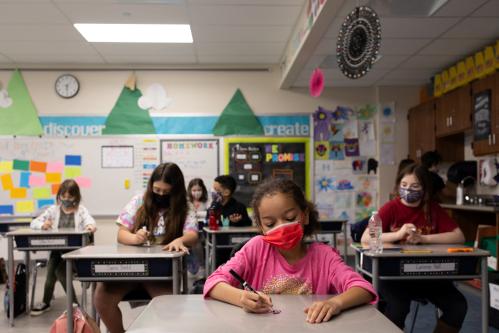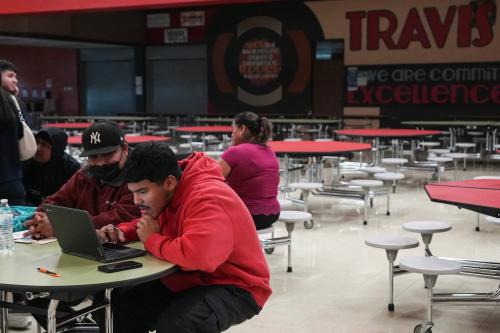Oklahoma is a deep-red state. In 2020, Donald Trump won the state with nearly two thirds of the vote. The state’s governor, both U.S. senators, and all five U.S. House members are Republicans. And the GOP holds about 80% of the seats in both chambers of the state legislature. So, when Governor Kevin Stitt and Oklahoma Senate leader Greg Treat declared a statewide school voucher bill a major priority for the 2022 legislative session, it might have seemed that its enactment would be a foregone conclusion. But when the legislature adjourned at the end of May, the voucher bill had failed by a vote of 24-22 in the Oklahoma Senate—and hadn’t even been called up for a vote in the Oklahoma House.
How could this happen? How could a bill supported by the Republican governor and introduced by the Oklahoma Senate leader fail to achieve a majority in a chamber where the GOP held more than three fourths of the seats? And why didn’t it even get to the floor of the Oklahoma House?
Well, in states like Oklahoma, it is common for issues—including, every now and then, education issues—to not just divide lawmakers along partisan lines but also along rural/urban ones. And this exact scenario played out with the private school voucher legislation.
Many rural Oklahoma school districts struggle financially. In this case, rural lawmakers were concerned that instituting a statewide voucher program would further stress the finances of their broadly popular public schools. Beyond that, there just aren’t that many educational options in rural parts of the state, which limits the appeal of voucher legislation to families in those areas.
Given these political dynamics, when the school voucher legislation came up for a final vote on the floor of the Oklahoma Senate, it commanded the support of just 21 of the chamber’s 38 Republicans. Nearly all of the 17 GOP legislators who voted against the bill represent rural areas of the state. Combining these 17 GOP “No” votes with near-unanimous Democratic opposition provided voucher opponents with just enough votes to torpedo the bill. Even if this bill had passed the Senate, though, it is unlikely that the legislation would have reached Governor Stitt’s desk. The Speaker of the Oklahoma House, who hails from a town with a population of about 3,000, had previously declared that the House wouldn’t hear the bill in the 2022 session.
Voucher politics resurface in the 2022 midterms
The politics of private school vouchers in Oklahoma extend beyond the 2022 legislative session and into this year’s gubernatorial race, which pits incumbent GOP Governor Kevin Stitt against Democratic challenger Joy Hofmeister. Hofmeister has an interesting backstory. She is currently Oklahoma’s Superintendent of Public Instruction, a post to which she was first elected in 2014 and subsequently re-elected in 2018. In an interesting twist, though, Hofmeister was elected to that position both times as a Republican. But a series of high-profile disagreements on school vouchers and other issues, coupled with the reality of term limits, spurred Hofmeister to switch parties and run against Governor Stitt in the gubernatorial election.
Hofmeister’s opposition to private school vouchers is one of the defining issues of her campaign this fall. To wit, it is listed first under the “Issues” section of her campaign website. And while Governor Stitt says a voucher program would “fund students, not systems,” Superintendent Hofmeister travels around the state referring to private school vouchers as a “rural school killer.” In sparsely populated areas of the state where public schools are a significant part of the economic and social fabric—they provide everything from employment to weekend entertainment and community gathering spaces—such a message might just be resonating with voters. If polling is to be believed, the 2022 gubernatorial race is looking like it will be a nail-biter, with recent polls showing a race that is much closer than the typical statewide Oklahoma election.
Although the multidimensionality of school voucher politics is on vivid display in Oklahoma, it is hardly the only state where these dynamics play out. Indeed, the urban/rural divide among GOP legislators on this issue almost certainly contributes to the lack of statewide school choice programs in other red states, including Wyoming, Iowa, Nebraska, Kansas, Alabama, Montana, Utah, the Dakotas, and, perhaps most notably, Texas. On the surface, the partisan and ideological composition of these states’ legislatures would seem to predispose them to school vouchers, and educational choice programs more generally. However, the realities of rural schooling cut across these partisan and ideological considerations and introduce a second major dimension to the politics of school vouchers in red states.
As with most policy topics these days, we’ve come to view a lot of education issues in purely partisan terms. Part of this is due to the reality that much of the education policy discussion is disproportionately driven by happenings in large urban districts and coastal states, contexts where partisanship often is the defining dimension. When we look beyond those contexts, though, we see that the political realities can be much more complex. This complexity will be visible in the 2022 midterms—but only if we’re willing to look beneath the surface.







Commentary
Rural resistance to statewide school vouchers
November 3, 2022